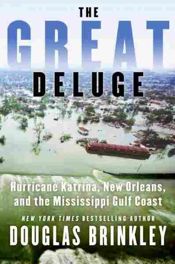The Great Deluge: Hurricane Katrina, New Orleans, and the Mississippi Gulf Coast

This is the almost-definitive history of Hurricane Katrina. I say “almost,” because it was written about a year after the 2005 hurricane, which means there’s probably some history since then that’s been missed.
This is 700 pages of misery, basically. New Orleans didn’t stand a chance under the best of circumstances, and human and political failings made it worse. Besides sitting famously below sea level and shaped like a “bowl,” the city had very high rates of elderly and poor residents. When they were told to evacuate, many simply…couldn’t. It was estimated that 110,000 resident didn’t have a car or even access to one, not to mention the money necessary to temporarily relocate.
(It didn’t help that Katrina happened at the very end of the month – August 29. People living paycheck to paycheck or on government assistance didn’t have a lot of money left by that point in the month.)
Katrina destroyed the city in waves:
First the wind and rain itself – the actual force the storm
Then the flooding when the storm surge hit and the levees burst
Then problems that standing water created, including disease and an inability to reach survivors
Then the violence that broke out – the riots and looting when societal norms and standards broke down
Finally, the long-term damage that was done to New Orleans’ reputation, and the racial stereotypes that were reinforced (see below for more on this)
The book covers the storm in detail, including the days leading up to it, the actual storm, and the week that followed, through the final emptying of the Superdome five days after the storm receded. There are a lot of characters and stories involved – the author interviewed hundreds of people – and it jumps back and forth in time. This got a little confusing, but I can’t see another way to cover an event like this.
My only criticism is that the author is very opinionated about who was at fault. He paints Mayor Ray Nagin in the worst possible light – calling him “despicable” and “the worst mayor in history.” Others don’t fare well either. The author also savages the New Orleans Police Department, FEMA head Michael Brown, and Homeland Security secretary Michael Chertoff. Maybe some of this is warranted, but there’s not even a passing attempt at objectivity.
Finally – and please give me a little grace here – what may have been the deepest damage of Katrina was the racial stereotypes it reinforced. New Orleans was mostly Black and poor, and the images coming out of New Orleans in the days following the storm invariably showed two things:
Black people unprepared for the storm, helpless after it, and depending on White people to save them
Black people becoming lawless and violent when society starting breaking down
If you were a racist, the television coverage of Katrina reinforced every negative feeling you’ve ever had about The Other. And this might be some of the most insidious and unmeasurable damage the storm did in the years since.
Book Info
- I have read this book. According to my records, I completed it on .
- A hardcover copy of this book is currently in my home library.